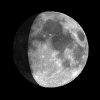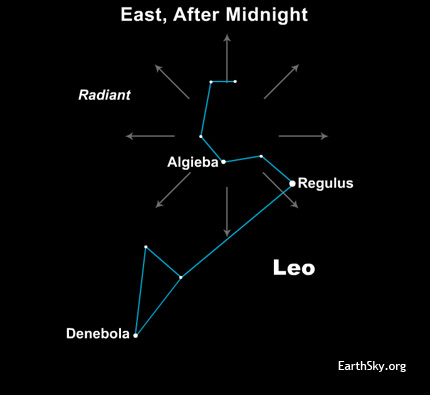Courtesy of EarthSky
A Clear Voice for Science
Visit EarthSky at
www.EarthSky.org [1]
 [2]
[2] [3]Here is the radiant point for the Leonid meteor shower. [4] The 2010 Leonid meteor shower is expected to peak before dawn on Wednesday, November 17, or Thursday, November 18. If you have a dark sky – far from city lights – you might see as many as 10 to 15 meteors per hour at the shower’s peak. The best time to watch will be after the moon sets in the wee hours before dawn.
[3]Here is the radiant point for the Leonid meteor shower. [4] The 2010 Leonid meteor shower is expected to peak before dawn on Wednesday, November 17, or Thursday, November 18. If you have a dark sky – far from city lights – you might see as many as 10 to 15 meteors per hour at the shower’s peak. The best time to watch will be after the moon sets in the wee hours before dawn.
Many ask about the radiant points of meteor showers. Please know that you don’t have to locate the radiant point to watch the Leonid shower, for these meteors will fly all through the starry heavens. Nevertheless, it’s fun to know where the radiant lies in the sky. When tracing the paths of the Leonid meteors backward, they appear to radiate from the constellation Leo the Lion. The meteors in this annual shower are named for this constellation. As seen from mid-northern latitudes, Leo rises over eastern horizon around 1 a.m. That is why you’ll see more meteors after midnight. After rising, Leo then swings upward and westward throughout the morning hours after midnight. It climbs to its highest point in the southern sky around 6 a.m.
We see the most Leonid meteors in the hour before dawn because that’s when Leo the Lion is found highest in the sky. This year, though, there’s another reason why we’ll be seeing more Leonid meteors in the predawn sky. In 2010, the bright waxing gibbous moon [5] won’t set till 3 or 4 a.m. How high up are meteors when they begin to glow? [6]
Every year – in November – our planet Earth crosses the orbital path of the Comet Tempel-Tuttle. Debris from this comet burns up in the Earth’s upper atmosphere to create the annual Leonid shower. Peak rates are generally around 10 to 15 meteors per hour, but this shower has also been known to create rich meteor storms. No Leonid meteor storm is expected for 2010, however.
By the way, if you happen to be outdoors in the evening, you’ll surely notice a bright light near the moon. That is our solar system’s largest planet, Jupiter. Enjoy Jupiter and the moon. Then wait for the moon to set – and watch for the Leonid meteors until dawn. In the dark hour before dawn breaks, the blazing planet Venus will ascend over the eastern horizon to light up the predawn sky.
Just find a dark sky away from pesky artificial lights, enjoy the comfort of a reclining lawn chair and sleeping bag, and enjoy the 2010 Leonid meteor shower.
Written by Bruce McClure [7]
Find out more about the Leonids here: Leonid MAC [4]
Astronomy Picture of the Day from NASA/JPL [8]
U.S. Naval Observator Astronomical Information cente [10]r
Universe Today [11]
StarDate Online [12]
Sky and Telescope [13]
National Geographic [14]
Space Com [15]
Simostronomy Blog [16]
Amazing Space [17]
The York County Astronomical Society [18]
Scope City [19]